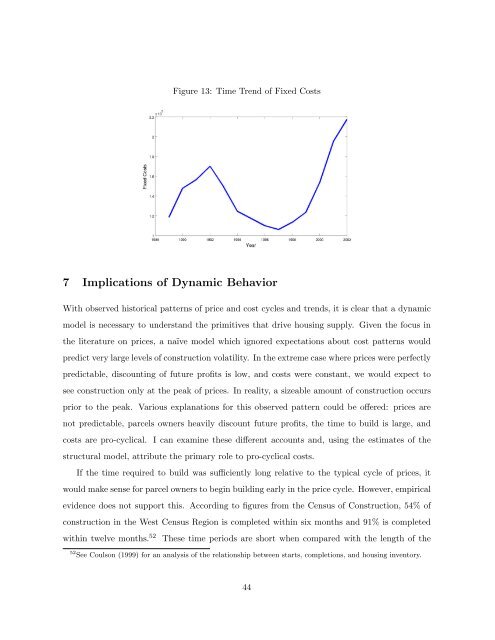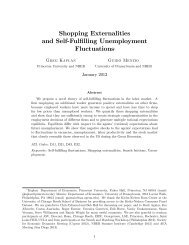A Dynamic Model of Housing Supply
A Dynamic Model of Housing Supply
A Dynamic Model of Housing Supply
Create successful ePaper yourself
Turn your PDF publications into a flip-book with our unique Google optimized e-Paper software.
Figure 13: Time Trend <strong>of</strong> Fixed Costs7 Implications <strong>of</strong> <strong>Dynamic</strong> BehaviorWith observed historical patterns <strong>of</strong> price and cost cycles and trends, it is clear that a dynamicmodel is necessary to understand the primitives that drive housing supply. Given the focus inthe literature on prices, a naïve model which ignored expectations about cost patterns wouldpredict very large levels <strong>of</strong> construction volatility. In the extreme case where prices were perfectlypredictable, discounting <strong>of</strong> future pr<strong>of</strong>its is low, and costs were constant, we would expect tosee construction only at the peak <strong>of</strong> prices. In reality, a sizeable amount <strong>of</strong> construction occursprior to the peak. Various explanations for this observed pattern could be <strong>of</strong>fered: prices arenot predictable, parcels owners heavily discount future pr<strong>of</strong>its, the time to build is large, andcosts are pro-cyclical. I can examine these different accounts and, using the estimates <strong>of</strong> thestructural model, attribute the primary role to pro-cyclical costs.If the time required to build was sufficiently long relative to the typical cycle <strong>of</strong> prices, itwould make sense for parcel owners to begin building early in the price cycle. However, empiricalevidence does not support this. According to figures from the Census <strong>of</strong> Construction, 54% <strong>of</strong>construction in the West Census Region is completed within six months and 91% is completedwithin twelve months. 52 These time periods are short when compared with the length <strong>of</strong> the52 See Coulson (1999) for an analysis <strong>of</strong> the relationship between starts, completions, and housing inventory.44
















